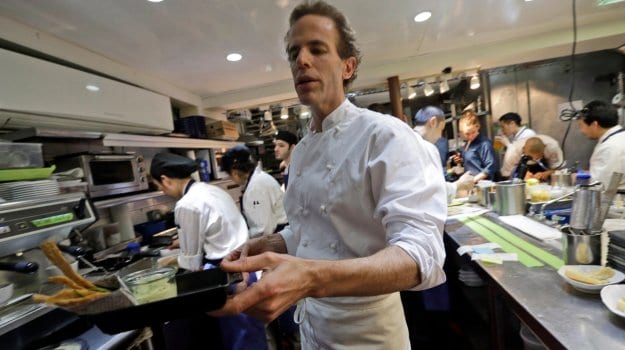Chef Dan Barber is unflinchingly proving that food waste can be deliciously repurposed. My old lettuce, I fear, is beyond help…
Few things in life are more shaming than poking around in the crisp box of your fridge (though one might be using the prissy and somehow very 70s term “crisp box” in the first place). For isn’t there always a heart-sinking moment at some point in the month when you reach down and pull up a stinking bag of yellowing kale, a too-bendy carrot, a tomato whose youthful blush has turned unaccountably to grey? Yes, my cupboards are occasionally just as mortifying: the other day, in search of chickpeas, I put my hand on a can whose vintage appeared to pre-date the coalition. But it’s my fridge that most often admonishes me for my profligacy, guilt surging queasily up through my stomach and thence into my arms and legs the better that it might paralyse me just as I’m halfway to the bin.
What’s to be done about waste? We all know the answer. We must buy vastly less, and shop more frequently, adding things to the list only when we truly need them. We need to plan meals, rather than pile up random ingredients, and to try not to deceive ourselves when it comes to the things we feel we should eat, but probably won’t in the end (one bag of kale will do). In the matter of “sell by” and “use by” dates, we must attempt to be both less absolutist and less squeamish. That cream that’s a little sour won’t be any good on the strawberries, but it will probably be fine in a sauce. And then there’s the problem of procrastination, our general failure of rubber-gloved nerve. Why do we avoid the back of the fridge? It’s so dumb. The longer we leave it, the more likely it is to be like a scene from Alien.
But perhaps we need to go further. In the New Yorker, I read a piece about Dan Barber, the chef at Blue Hill in the West Village, and its upstate sister restaurant and farm, Blue Hill Stone Barns. Last month, Barber turned Blue Hill into a two-week pop-up called wastED (I know; the name does rather make you want to grind Barber’s bones and sprinkle them over one of his parsnip creations). On its menu, all the stuff that usually gets thrown away, repurposed: a meatloaf made with offal from a cow bred exclusively for milking; a dish of pasta trimmings served with monkfish tripe; a charred pineapple core served with candied mango skin and lime-leaf ice cream.
But it wasn’t these dishes that caught my attention. As Barber points out, all restaurants use “waste”: last night’s braised meat is tomorrow’s ravioli; yesterday’s langoustine will soon be bisque. No, it was the way the menu had been written that made me gasp. The baldness of it, the unyielding asceticism. A salami plate was described as “cured cuts of waste-fed pig”. What turned out to be a flavourful bowl of brodo was described as “dry-aged beef ends broth” with “mystery vegetables and peels”. The meatloaf I mentioned was called “dog food” with “unfit potatoes and gravy”. Nothing sounded even remotely alluring. It was as if Barber had taken some bizarre truth drug. Of course, modish chefs tend to like to challenge their customers from time to time. This is deliberate. A whole culture has grown up, or at least it has in east London, based around a certain kind of foodie daring (“Look at me, I’ll eat anything!”). Barber’s gauntlet, though, was of a different order altogether. He seemed to me to be asking his customers completely to reprogramme their brain-tastebud nexus. In the gap between his austere descriptions and the deliciousness of the dishes themselves – the reporter from the New Yorker loved every mouthful, up to and including a “scrap salad” that tasted faintly of the kitchen sink – there hovers the amazing possibility that, in our wastefulness, we are actively missing out when we chuck stuff away.
Isn’t this a better, more positive way of making people think about waste than simply to rail against it for, say, the damage it does to the planet? Surely it must be, particularly in the arena of the kitchen, where our moral and ethical burdens seem to grow greater almost by the hour. The only problem is: how to translate Barber’s ideas into something we can all do at home? In the absence of any monkfish tripe or even a lowly pineapple core, a few minutes ago I ransacked my fridge in search of (previously) unknown pleasures. My initial feeling is that this project is going to be … challenging. The lettuce that greeted me – I mean this literally, for it almost jumped into my arms – was the colour of custard, its drenched, drooping leaves like the tentacles of freshly landed octopus.
Top Photo: Chef Dan Barber at his pop-up wastED in New York. Photograph: Mary Altaffer/AP







